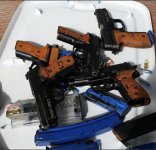I will predict that any kind of “training” is way better than standing at a lane in the your favorite range and shooting a paper target at 7 yards, with your finely tuned and fondled defense handgun, while your range buddies looking on are all admiring your shots grouped in 3” circle at semi-rapid fire.
The assumption of predictability while doing force on force simulations may be the closest thing to an actual instantaneous adrenalin-pumping shoot-to-save-your-life situation.
The list of unpredicted, unprepared for actions that occur in a few seconds can be over-powering even with the best training.
I flash back to about age 15. My close next-door neighbor Bob, growing up together from early childhood, got into boxing. He would talk about it from time to time. At that time, I started weight training. I had no interest in boxing or self-defense. We were close to the same size, he was a little heavier. One day he challenged me to put on some gloves and spar with him. I was somewhat reluctant because I had never boxed before. We started off just moving around and throwing some air jabs. Then it got a little more serious with him landing a couple punches on my chest and head. My adrenaline kicked in and I threw a bunch of quick jabs right back. He was very surprised that I landed some heavy blows that he tried to avoid. What he did not anticipate and was not prepared for is that I have a 73” wing span. My punches could reach his body and his shorter arms could not reach me. After about 15 minutes we stopped. He was very surprised and taken back a little by that boxing “match”.
After that he never asked me to box with him again.
In our sophomore year in high school, we got harassed by some seniors. One day at lunch, Bob and I were playing shuffle board in the student lounge. An unprepared and unknowing senior confronted Bob and started harassing him. Bob only took his harassment for about 5 seconds, Bob through a quick punch to the guy’s face with his right hand. The guy never knew what hit him, he flew backwards landing on the floor, blood spurting from his lips. The bad news is Bob broke his hand. The good news is no seniors harassed him again.
So, you never know what you can’t know.

